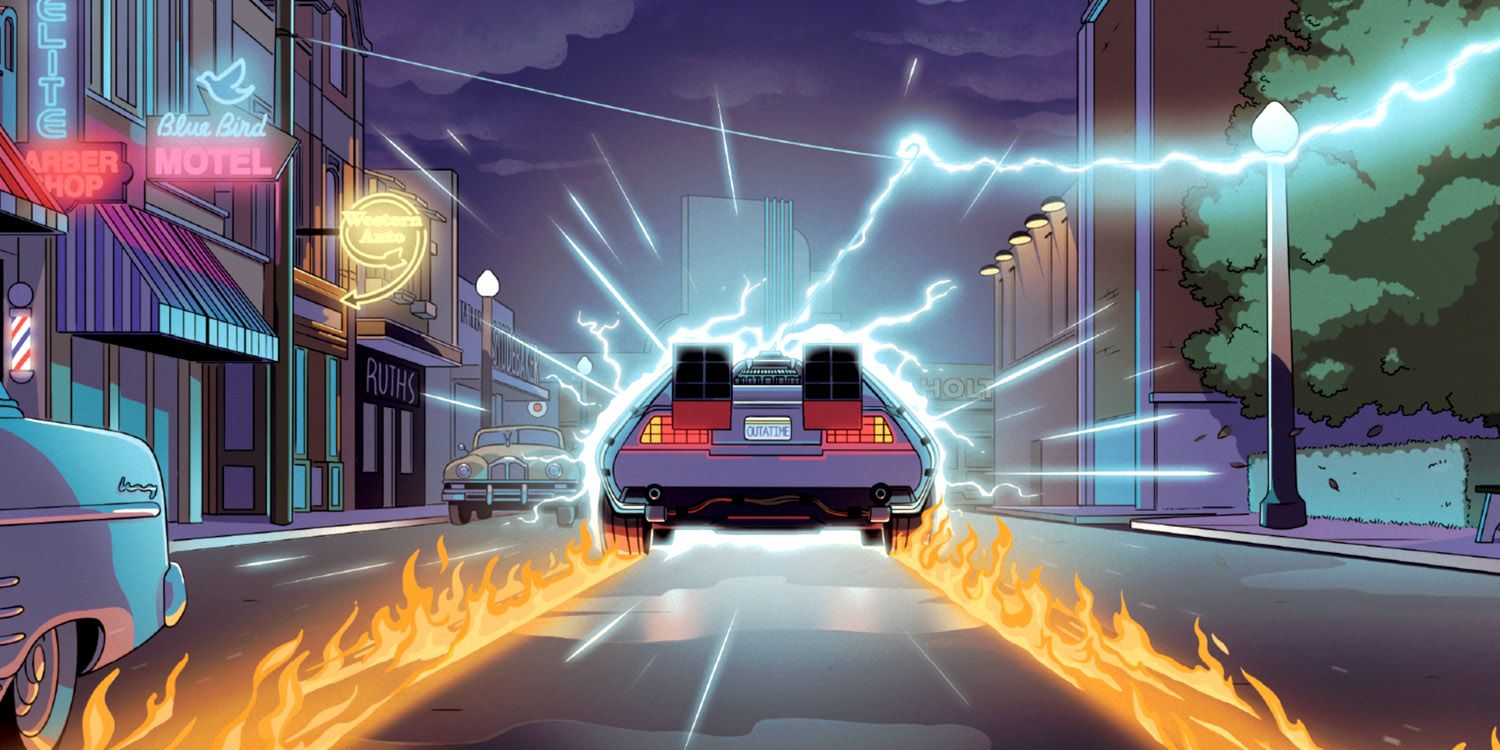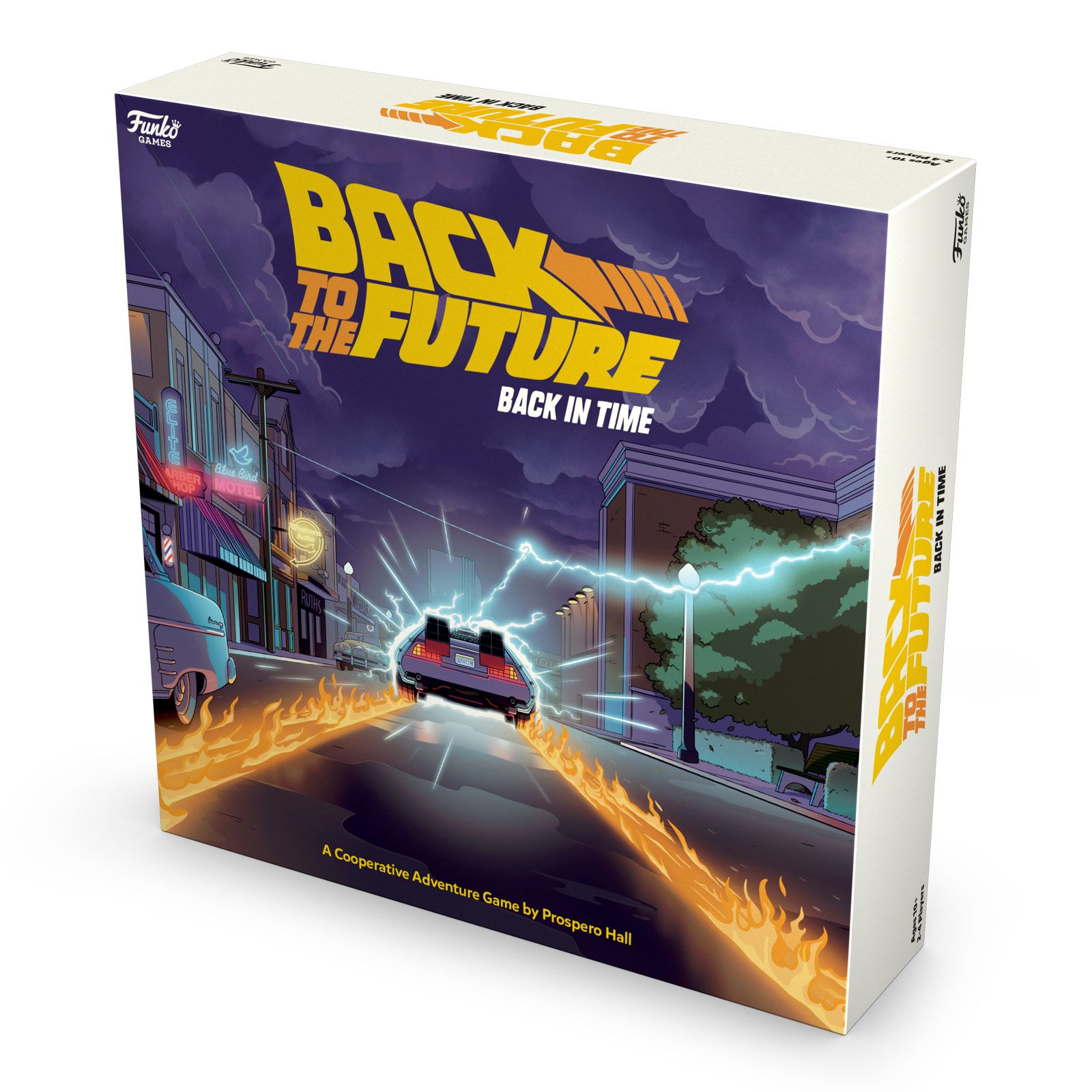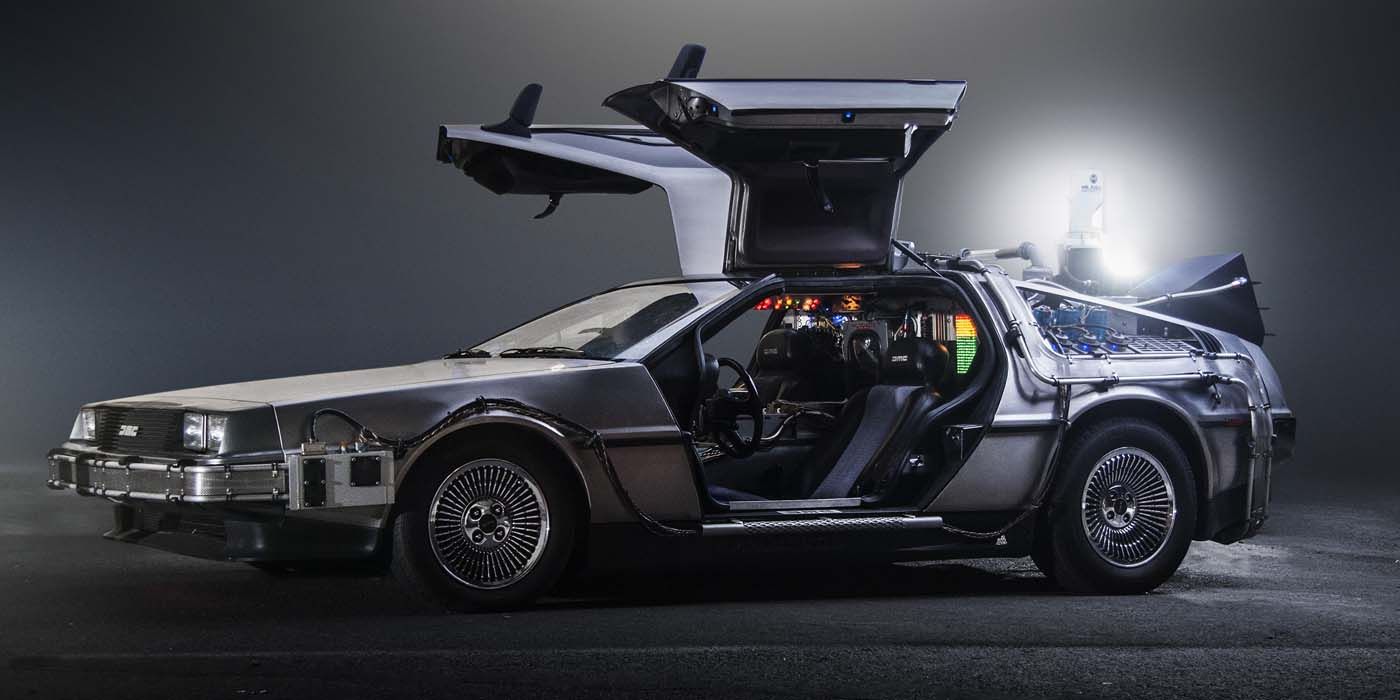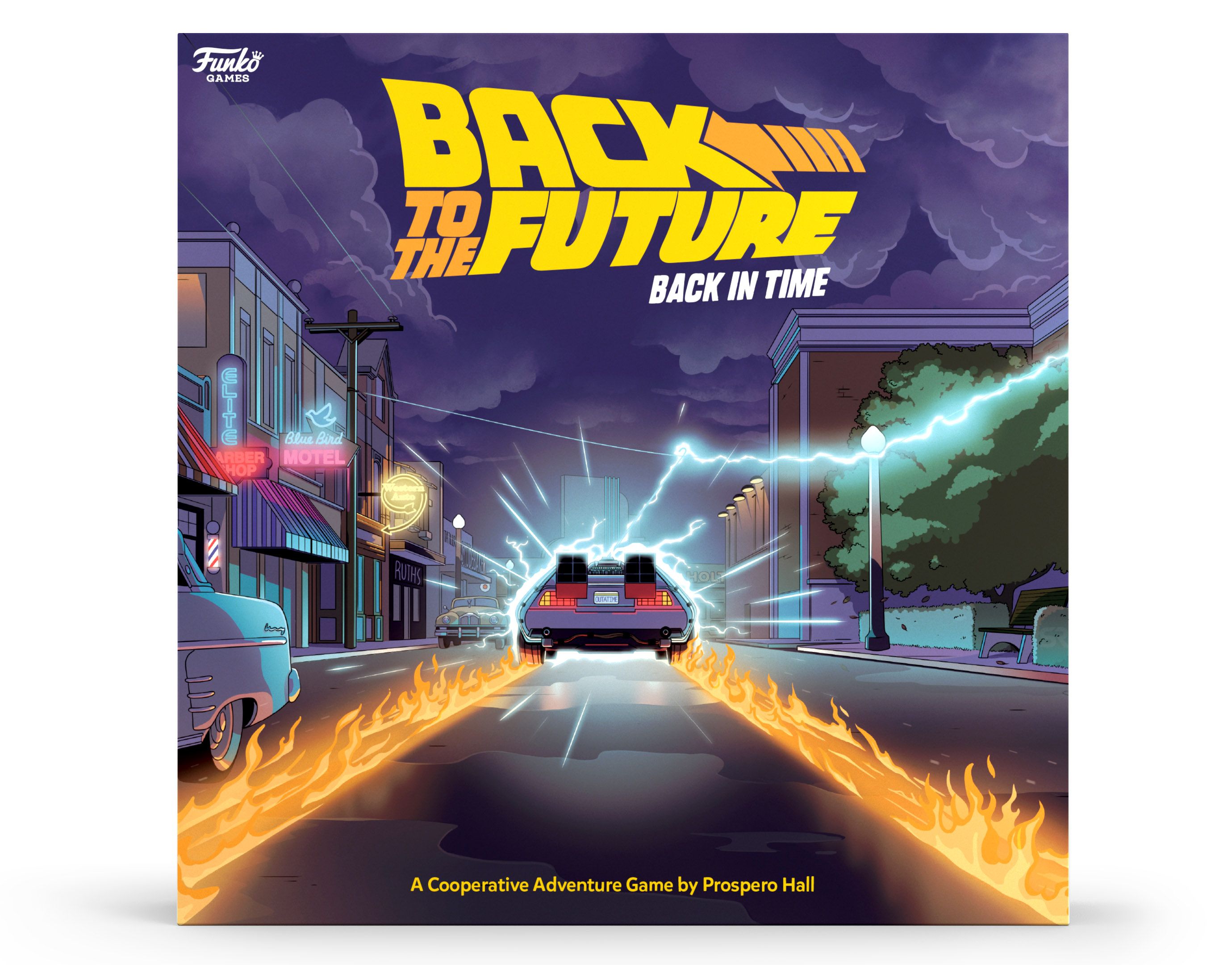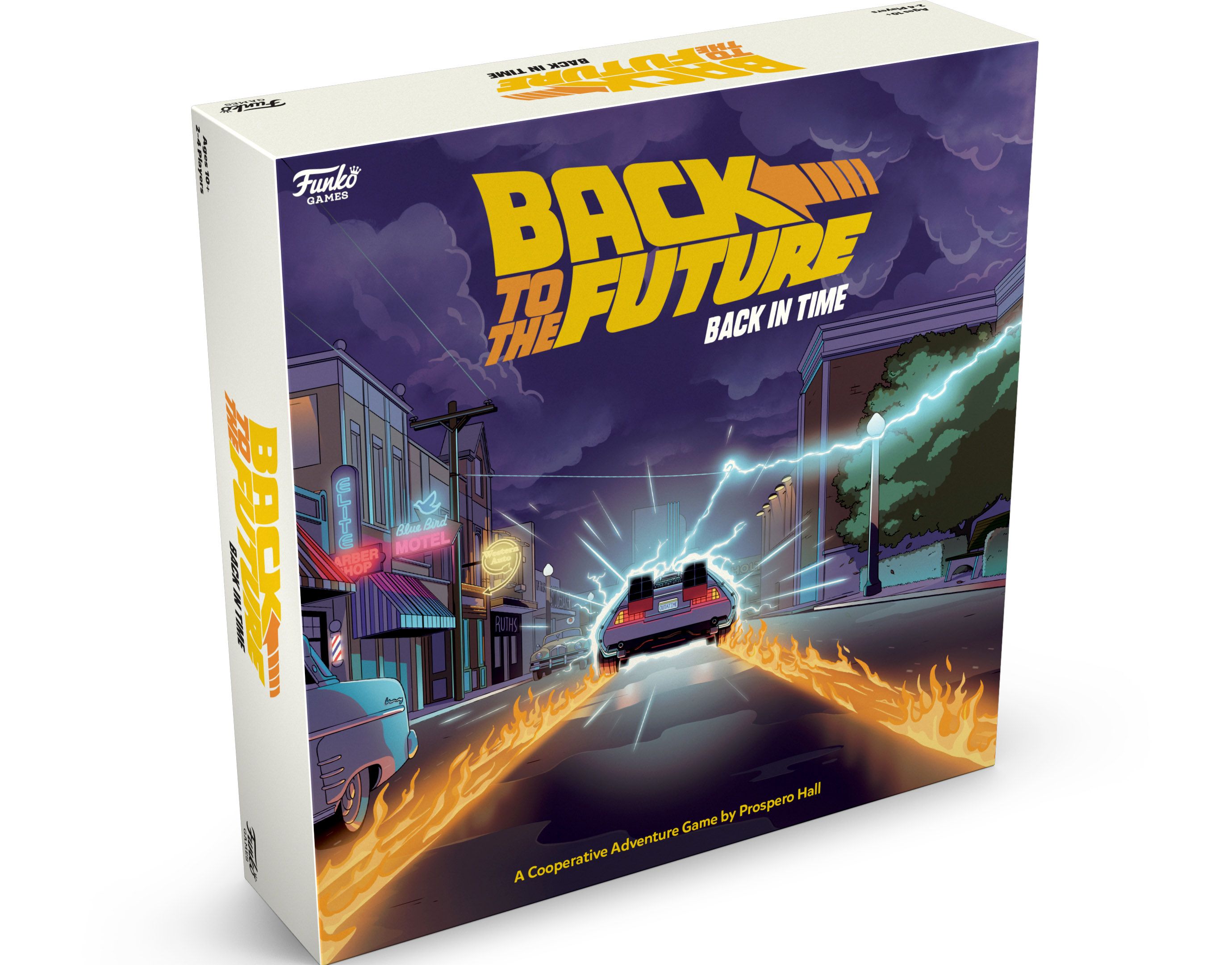In 1985, one of the most beloved movies in history was created - Back to the Future. The franchise was so popular that it spawned two sequels, countless video games, a short-lived animated series, and continues to be referenced in modern pop culture, including Ready Player One (another Amblin Entertainment property), inspired Rick and Morty, and most recently, was referenced significantly during the third season of Stranger Things.
With its 35th anniversary coming up, Back to the Future is front and center in the current pop culture zeitgeist. To that end, Funko has teamed up with Prospero Hall (who they acquired in 2019) to establish Funko Games. That new arm of their company is producing a new board game based directly on the characters and story from the movie. Prospero Hall has produced a string of board game hits that have had the rare success of crossing over from the hobbyist world into the general consumer market, which include Horrified, Jaws, Bob Ross: Art of Chill, and Disney's Villainous.
Back to the Future: Back in Time is a fully cooperative, family-oriented game for 2-4 players ages 10 and up that plays in under an hour. In the game, each player takes on the role of a major character from the movie - Marty McFly, Doc Brown, Jennifer Parker and Einstein the dog. The objective of the game is to have the characters move around 1955 Hill Valley, collecting certain items in an effort to fix Doc's famous DeLoreon time machine, defeat Biff Tannen and his gang of trouble-making friends, while ensuring that Marty's parents fall in love. Only when that is accomplished can players then accelerate the DeLoreon to 88 mph down Main Street before the clock tower strikes 10:04 pm!
The game comes in a standard 10.5" x 10.5" x 2.5" box with a single-sided game board, a fully-painted DeLoreon miniature, seven (7) 1.5" single-color mold-injected character movers, 8 painted dice, four (4) player mats, along with various illustrated tokens, cards, tiles and game cubes. In addition, the Hill Valley Clock Tower becomes a usable dice tower during game play. All the components will be pre-punched and placed in handy resealable bags for easier storage and game prep.
It should be noted, that Back to the Future: Back in Time is not stylized in the way many fans of Funko might be expecting. Instead, all the art and design work is original to this game and is not connected visually to Funko or the new Funkoverse gaming engine.
We had a chance to interview Deirdre Cross, Director of Product Development at Funko Games, to talk about their upcoming Back to the Future: Back in Time board game, how it plays, how it was developed and her opinions on why the board game hobby is becoming more popular in the mass market.
Screen Rant: How long have Funko and Prospero Hall been working on this "Back to the Future Game"?
Deirdre Cross: We've been working on this since Spring of last year. About 10 months or so.
And how many people worked strictly on the game design?
Cross: On just game design? Four designers.
Have any of them worked on any previously released Prospero Hall games?
Cross: This particular team, our studio is pretty big and folks move around a lot onto different projects, so the teams kind of form and reform, especially around properties that people are very passionate about. In this case, these designers had most recently worked on "Jaws", which wasn't published by Funko Game but by another publisher [Ravensburger] and some of the folks on this team also worked on our Funkoverse game system.
Speaking of Funkoverse, it's mainly a versus gaming engine. That is, it's team-vs-team or player-vs-player. This "Back to the Future" game uses a co-op engine. What was the driving factor behind making this significant change in design?
Cross: What we're talking about today is not the Funkoverse "Back to the Future" game. This is "Back to the Future: Back in Time", which is a signature game experience. It is not part of the Funkoverse system. It is totally outside of that.
So the characters from the Funkoverse are not interchangeable with the characters from the "Back to the Future: Back in Time" game?
Cross: There is a "Back to the Future" Funkoverse edition, but that is not related to our "Back to the Future: Back in Time" signature game. They are totally separate properties.
Was this game always intended to be a fully co-op game, unlike some of Prospero Hall's other games, like "Villainous" where it's 1-versus-all or "Jaws" where it's 1-versus-many?
Cross: When we're working on something like "Back to the Future", and this is really core to our Prospero Hall process, we explore many different avenues of what the game could be. We're really guided by the property itself, what the feeling is when you're watching it, on a historic piece like this - the 35th anniversary of "Back to the Future". This property holds a really special place in people's hearts, from their youth or from their childhood. So we try to get back to the feeling. So when we talk about "Back to the Future", the story itself is about cooperation between Doc and Marty. In the original story, of course, Marty travels back in time because Doc has died - spoiler alert! So he goes back but once he gets there they're immediately working together. It was very obvious to us that there would be some element of cooperation in here. Then we start thinking, "Do we want anyone playing as Biff, Strickland or any other nemesis from the movie?" but how does that manifest itself? We went down many paths trying to figure that out. I know that I played many versions of this game over the last year and it evolves - this is part of our process - into something that connects with you in a way that when you play the game you feel like you are in your own version of the film. That was really important to us.
The game description mentions eight figures: Marty, Doc, Jennifer and Einstein are playable characters. Of course, George and Lorriane are characters as well, and you mentioned Biff Tannen - that's seven. Who is the eighth?
Cross: Those are the seven characters that move around the board and then, I suppose, the eighth miniature would be the DeLereon itself, which you have to move around the board and get it in place to be ready to take off when the lightning strikes.
So the DeLoreon is a co-op piece that players move as a team, not necessarily a playable item?
Cross: Yeah, that's right. You can't play as the DeLoreon but you're going to need to move the DeLoreon. From its starting position, you're going to need to get it to Doc's house so that you can repair it and then you're going to have to move it back out to the ready zone - just like in the film.
Does the game follow a strict outline of the movie's timeline or are players allowed to move around a little bit inside of that universe?
Cross: So, when the game starts players have already traveled back in time to 1955 and that's where the game starts. Now, every time we setup the game it's going to be a little bit different. There's a central game board but there are different things that are happening, events, trouble or opportunities around the board that will be different every time you set it up. But we're always going to start back in 1955 and the object of the game will always to work together to get George McFly and Lorraine Baines, Marty's parents, to fall back in love. Then, we have to drive the DeLoreon down Main Street and be ready to go when lightning is going to hit the clock tower. So from a story perspective we always know that we'll start with a DeLoreon that needs parts to repair, we have to get our parents back to together and then we have to get back to the future. That's going to be consistent every time, but how that plays out is going to be different every time, including the kinds of trouble and issue you encounter will vary from play-to-play.
Funko is known for its particular form of stylized Pop! figures. What type of miniatures can we expect in this game? What makes this uniquely Funko?
Cross: Well, what makes this product uniquely Funko is our connection to the fandom. If you go out to the highest level of what Funko is about, it's about fans connecting to their favorite fandoms and, whether it's Pop! figures or handbags with our Lounge Fly division, or if its water bottles - there's so many other things. But when you get to the game side of things we aren't connecting to a necessarily a type of aesthetic, we're connecting to a passion for Back to the Future and connecting with fans in a way that's really meaningful. So, the figures are not stylized in a way that looks like Pop! They are stylized, but they're stylized in a comic book style that's uniquely illustrated to relate to "Back to the Future".
Will the character miniatures in this game be fully painted, like we do see with general Pop! stuff? I know you said it's not stylized like Pop! but Funko is known for having all of its characters pre-colored, whereas some of the other gaming systems that Prospero Hall puts out are generally all one color.
Cross: In this case, the characters themselves are a single-color injection, similar to our "Horrified" game that we did last year. But they're very detailed sculptures in their own right, so we wouldn't be surprised if we saw people painting them on their own. We kind of saw that last year with "Horrified". However, our DeLoreon mover is painted. It's very, very cute. They're all in scale with each other.
Who did the artwork for this project?
Cross: We paired with a fantastic artist for our artwork on this product. His name is George Bletsis. He's super-talented. You can see his art on the cover of the box and is the inspiration for how we handled the sculpts of the characters themselves. He's a very talented guy and we were thrilled to work with him. The figures are about 1.5" tall, standard game miniatures and they're in scale with the small painted DeLoreon that's in the product.
And he did all the art for the game?
Cross: He did the artwork for the box. We had a combination of folks who work on the art, because there's so much of it. There's actually three different artists outside of our team who worked on the game, George Bletsis probably being the most famous. Then other guy named Les McClaine and other guy named Steve Scott. There's a ton of original artwork in the game of all the events that are happening, all the trouble going on - we're really obsessed with the details. So these guys helped us execute all that.
Looking at the 50-minute play time, that would indicate that you guys have created a fairly-light, not overly-complex game. Would that be a correct assessment and would you say it's heavier or the same as the Funkoverse game engine?
Cross: Well, that's an interesting question. We're pretty obsessive about our rules writing because one of our main objectives in our Prospero Hall work is to bring hobby-style, richer more interesting game play, to the mass market game aisle and beyond. But what we're looking to do is put a game in front of someone who may not perhaps even pick up a hobby-style game. In the mass [market gaming] aisle you might encounter someone who's never played anything more complicated than "Monopoly" in the last twenty years. So we want to have a game experience that people are going to be able to jump right into. Now connecting really deeply with the story in the original film is a shortcut for people to understand the mechanics of the game. We've got cooperative game play because it makes complete sense. If you've never played a game this, "but of course we're working together", I can immediately understand that. You don't have to explain me the nuance of that. It just makes sense. So as the game itself is unfolding, because the storytelling is baked in, it makes sense to us that this is how works, even if what we might be introducing is something more richly textured or nuanced than what you might expect from a mass market game. But, it's interesting that you're perception is "50 minutes? Oh that's a light-weight game." Because you have a lot of experience playing. But for someone else coming in - people forget that something like "Monopoly", the full version, takes several hours to play - people's experience with a new game might be thinking it would be shorter. We try to hit in that sweet spot at or below an hour of play because we want people to come back to this and do it again and again, which is something that goes with a cooperative game, as well. You are going to lose this game occasionally. When you're playing something like Horrified you will not always win, and that's part of the fun of a cooperative game, of course - winning and losing together. The shorter game play time of 50 minutes is going to let you say, "You know what? We just lost. We got stuck back in 1955, let's reset it and start again. We'll have time for that."
How does Back to the Future differ from Prospero Hall's other games - "Jaws", "Horrified" or "Jurassic Park: Danger"? What sets it apart?
Cross: Every one of those experiences, every one of those games you described, each one is bespoke. It starts with us watching or re-watching, in the case of "Back to the Future", the original film again and again, but also the whole trilogy, and us distilling that into the story we want to tell and how we want to feel when we play it. That's going to be consistent across everything we're doing in Prospero Hall. But there's no set thing. The game board isn't double-sided, like "Jaws". It's not straight-up competitive, like "Villainous". There's no special formula. Each one of these games is truly hand-crafted over months and months of development and play testing. I can't really tell there's some special formula other than that, we are relentlessly obsessed with the details.
A lot of hobby game manufacturers don't produce games to reach a wide audience. They're happy sticking to Kickstarter and specialty hobby stores. Lately, Prospero Hall has been very successful in reaching both avid gamers and recreational gamers, making big box stores like Target and Wal-mart a place to go for all players looking for something that's a little more in-depth than say, "Candyland" or "Monopoly". That has not always been the case and Prospero Hall may be leading the charge in that regard. What do you think is reason behind Prospero Hall's success, and to a larger degree, Funko's success, in reaching that wider audience?
Cross: What we've had over the last - and I would say this evolution is the game aisle has been happening in the last 5 to 6 years - are really amazing partners at the big box retailers, both Wal-mart and Target, and those stores have taken notice that more people are interested in playing games and that there is a broad range of game-playing folks. Here at Prospero Hall and Funko Games we are interested in all levels of gaming and we're interested in bringing new people into this hobby. We're obsessed with turning new people into gamers and the way we do that is with great story telling on the table. You might find that a lot of people just happen by the game aisle and something catches their eye. That's why we pay a lot of attention to the art in our games, the packaging and the presentation - because we've got to catch people's eye. But then once they open up that box we need to connect with them on a really deep level to get them to stick around. The more we do that, the more we're going to be able to bring people back to the [gaming] aisle and that's why year-over-year we're making more and more space for this kind of entertainment experience. Fifteen years ago, a hobby-style game had to start in [the] hobby [market] and gestate in [the] hobby [market]. Something like "Catan" started there but eventually grew so big that it made it to [the] mass [market]. Now what we're seeing is the mass market is willing to take a chance on a more interesting and rich game play. Then, by doing that, we have the opportunity to send this product the other direction into the market place, so that we can then also be in our Friendly Local Game Stores with other big license properties. And you see this happening with a lot of different publishers because it allows people to have an opportunity to make some bigger plays. We're so excited to be a part of this big cultural moment in the expansion of board gaming across all the major aisles.
The people in the hobby is great for people who love to play, because that gives us a chance to play with other people.
Cross: Yeah, I think there's so much there about getting a game out on the table, and particularly a cooperative game like our "Back to the Future" signature game. We sit down with our family. We already love this movie. This franchise. That's something that we've already watched together and we're going to sit down and for an hour, we're going to do this thing. We're looking at each other. We're connecting to each other. We are having this shared experience together and I think more and more people are kind of desperate for that connection. It's a great opportunity. I think that's why the industry is growing so much, is that it just feels so good to sit down and do this, that people want to stay and do it.
Prospero Hall likes to expand games, like they did "Villainous", where they just continue to add new characters which are stand-alone and playable, but you can also mix them with the original base game. Are there plans to do that with this "Back to the Future" game, for say, II and III, where you bring in additional characters and scenarios, while still maintaining the original base game?
Cross: There's no announced plans yet, but it's always exciting for us to work on product that is part of a franchise because of that design space that can remain if something really resonates, there's a lot of opportunity for us to continue the story.
Does Funko or Prospero Hall have any future plans to bring games to the market which aren't based on existing IPs, like movies and TV?
Cross: Yeah, we definitely do have non-licensed work coming, as well. I think that material and those announcements will be coming over the next few weeks leading up to [American International] Toy Fair.
Does Funko have any more partnership plans coming with Prospero Hall you’d like to share with our readers?
Cross: Well, there are many other things that are about to be announced but "Back to the Future" is a big one for us. It's a beloved property for us. This is one of the first that are being announced, but there are several big Prospero Hall projects coming this spring and summer.
Back to the Future: Back in Time the board game by Funko and Prospero Hall will be available in all retail outlets and hobby stores in Summer 2020.
More: Funkoverse

